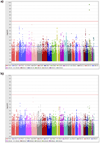Genome-wide association study of Alzheimer's disease with psychotic symptoms
- PMID: 22005930
- PMCID: PMC3272435
- DOI: 10.1038/mp.2011.125
Genome-wide association study of Alzheimer's disease with psychotic symptoms
Abstract
Psychotic symptoms occur in ~40% of subjects with Alzheimer's disease (AD) and are associated with more rapid cognitive decline and increased functional deficits. They show heritability up to 61% and have been proposed as a marker for a disease subtype suitable for gene mapping efforts. We undertook a combined analysis of three genome-wide association studies (GWASs) to identify loci that (1) increase susceptibility to an AD and subsequent psychotic symptoms; or (2) modify risk of psychotic symptoms in the presence of neurodegeneration caused by AD. In all, 1299 AD cases with psychosis (AD+P), 735 AD cases without psychosis (AD-P) and 5659 controls were drawn from Genetic and Environmental Risk in AD Consortium 1 (GERAD1), the National Institute on Aging Late-Onset Alzheimer's Disease (NIA-LOAD) family study and the University of Pittsburgh Alzheimer Disease Research Center (ADRC) GWASs. Unobserved genotypes were imputed to provide data on >1.8 million single-nucleotide polymorphisms (SNPs). Analyses in each data set were completed comparing (1) AD+P to AD-P cases, and (2) AD+P cases with controls (GERAD1, ADRC only). Aside from the apolipoprotein E (APOE) locus, the strongest evidence for association was observed in an intergenic region on chromosome 4 (rs753129; 'AD+PvAD-P' P=2.85 × 10(-7); 'AD+PvControls' P=1.11 × 10(-4)). SNPs upstream of SLC2A9 (rs6834555, P=3.0 × 10(-7)) and within VSNL1 (rs4038131, P=5.9 × 10(-7)) showed strongest evidence for association with AD+P when compared with controls. These findings warrant further investigation in larger, appropriately powered samples in which the presence of psychotic symptoms in AD has been well characterized.
Figures

References
-
- Hollingworth P, Harold D, Jones L, Owen MJ, Williams J. Alzheimer's disease genetics: current knowledge and future challenges. Int J Geriatr Psychiatry. 2010 - PubMed
-
- Zhang Q, Yu JT, Zhu QX, Zhang W, Wu ZC, Miao D, et al. Complement receptor 1 polymorphisms and risk of late onset Alzheimer's disease. Brain Res. 2010 - PubMed
Publication types
MeSH terms
Substances
Grants and funding
- P30 AG010124/AG/NIA NIH HHS/United States
- P30 AG028377/AG/NIA NIH HHS/United States
- MC_U123160651/MRC_/Medical Research Council/United Kingdom
- P30 AG010161/AG/NIA NIH HHS/United States
- R01 AG041797/AG/NIA NIH HHS/United States
- P50 AG005138/AG/NIA NIH HHS/United States
- P30AG10161/AG/NIA NIH HHS/United States
- P50 AG016582/AG/NIA NIH HHS/United States
- P30AG028377/AG/NIA NIH HHS/United States
- AG027224/AG/NIA NIH HHS/United States
- P50AG05138/AG/NIA NIH HHS/United States
- P30 AG013854/AG/NIA NIH HHS/United States
- P50AG05134/AG/NIA NIH HHS/United States
- P30AG028383/AG/NIA NIH HHS/United States
- P50AG005133/AG/NIA NIH HHS/United States
- MC_U123160657/MRC_/Medical Research Council/United Kingdom
- P50 AG005142/AG/NIA NIH HHS/United States
- P50AG016582/AG/NIA NIH HHS/United States
- P50AG08702/AG/NIA NIH HHS/United States
- P30 AG010133/AG/NIA NIH HHS/United States
- U24 AG021886/AG/NIA NIH HHS/United States
- P50 AG008702/AG/NIA NIH HHS/United States
- P50AG165574/AG/NIA NIH HHS/United States
- P50AG016579/AG/NIA NIH HHS/United States
- G0300429/MRC_/Medical Research Council/United Kingdom
- 082604/WT_/Wellcome Trust/United Kingdom
- P01 AG003991/AG/NIA NIH HHS/United States
- P50 AG005681/AG/NIA NIH HHS/United States
- P01AG05138/AG/NIA NIH HHS/United States
- P30 AG013846/AG/NIA NIH HHS/United States
- U24 AG056270/AG/NIA NIH HHS/United States
- P30AG10124/AG/NIA NIH HHS/United States
- P30AG12300/AG/NIA NIH HHS/United States
- P50AG05142/AG/NIA NIH HHS/United States
- P30AG13854/AG/NIA NIH HHS/United States
- R01 MH057881/MH/NIMH NIH HHS/United States
- P01AG03991/AG/NIA NIH HHS/United States
- G0902227/MRC_/Medical Research Council/United Kingdom
- P50 AG005136/AG/NIA NIH HHS/United States
- P30 AG012300/AG/NIA NIH HHS/United States
- U24AG021886/AG/NIA NIH HHS/United States
- G0800509/MRC_/Medical Research Council/United Kingdom
- HHSN268200782096C/HG/NHGRI NIH HHS/United States
- R01AG027224/AG/NIA NIH HHS/United States
- P01AG02219/AG/NIA NIH HHS/United States
- P50 AG005134/AG/NIA NIH HHS/United States
- P30 AG008017/AG/NIA NIH HHS/United States
- P30AG013846/AG/NIA NIH HHS/United States
- U24 AG026395/AG/NIA NIH HHS/United States
- R01AG030653/AG/NIA NIH HHS/United States
- P30AG008017/AG/NIA NIH HHS/United States
- P30AG010133/AG/NIA NIH HHS/United States
- P50AG05136/AG/NIA NIH HHS/United States
- P50 AG005133/AG/NIA NIH HHS/United States
- P01 AG002219/AG/NIA NIH HHS/United States
- R01 AG030653/AG/NIA NIH HHS/United States
- R01 AG027224/AG/NIA NIH HHS/United States
- U24AG026395/AG/NIA NIH HHS/United States
- P50AG05681/AG/NIA NIH HHS/United States
- 095317/WT_/Wellcome Trust/United Kingdom
- P30 AG028383/AG/NIA NIH HHS/United States
LinkOut - more resources
Full Text Sources
Medical
Miscellaneous

